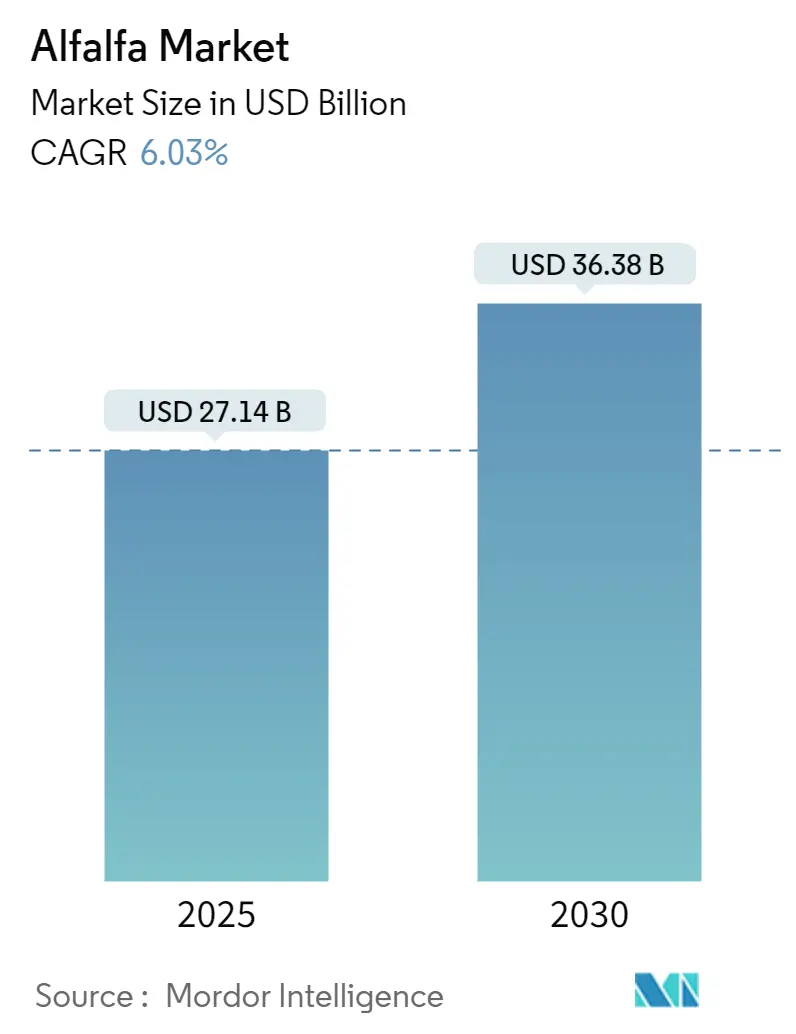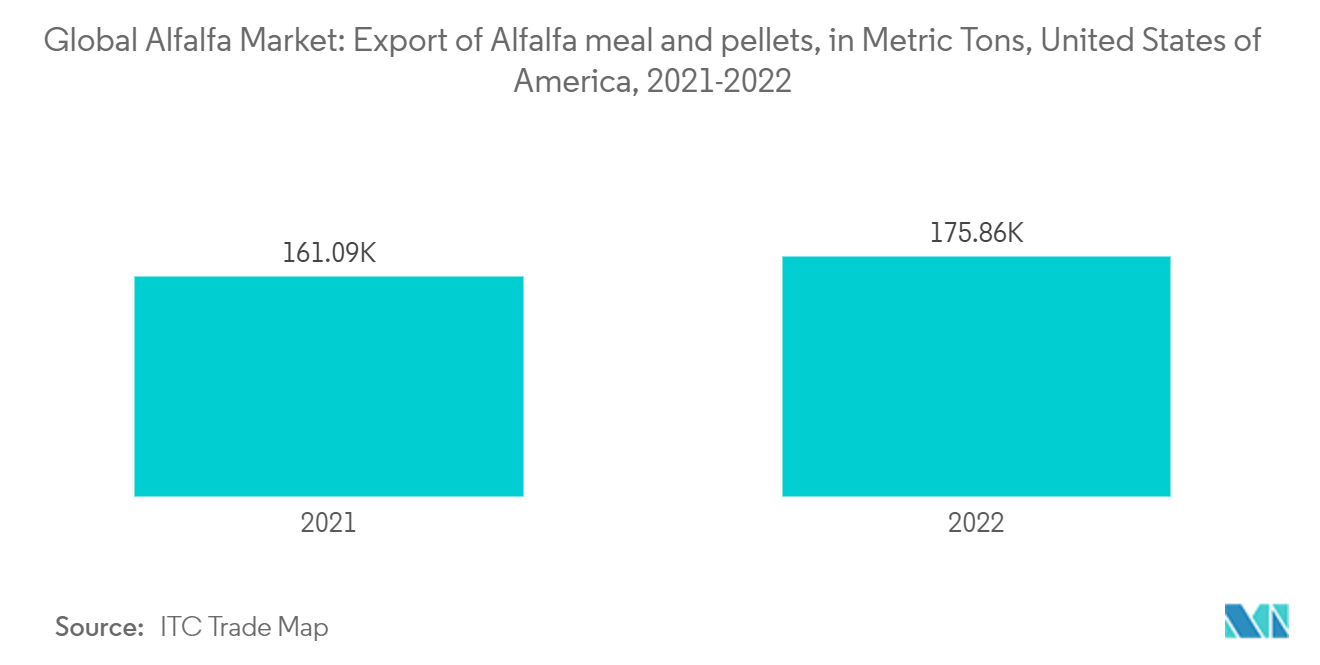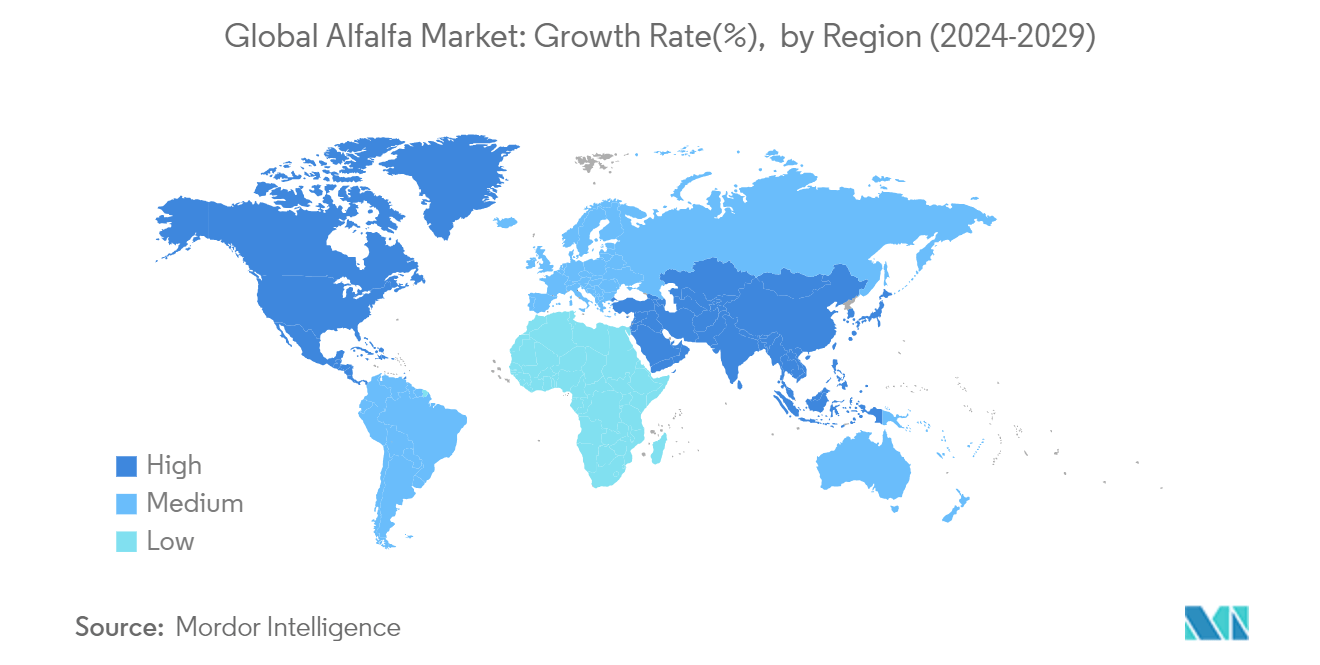
Alfalfa Market Analysis
The Alfalfa Market size is estimated at USD 27.14 billion in 2025, and is expected to reach USD 36.38 billion by 2030, at a CAGR of 6.03% during the forecast period (2025-2030).
Alfalfa, a perennial forage crop, is renowned for its rich protein content and abundance of vitamins A, K, and E, along with essential minerals. Its adaptability to diverse climates and soil types has led to its widespread cultivation across more than 80 countries, covering an area of 30 to 35 million hectares, according to the Crop Trust. The alfalfa market is primarily driven by the escalating demand for high-quality hay to feed the growing livestock and cattle populations, fluctuations in alfalfa hay prices, and the competitive pricing of alternative feeds and forages. In recent years, alfalfa hay has become increasingly vital in poultry nutrition and, subsequently, in general animal feed, owing to its significant crude protein content. Notably, the United States and Argentina are the major alfalfa-producing countries in the world.
North America is set to dominate the alfalfa market. Key importers of alfalfa hay from the United States include China, the United Arab Emirates, and Saudi Arabia. On the global stage, the United States and Spain stand out as the primary exporters of alfalfa. For instance, according to the USDA, in 2023, the United States exported 898,186 metric tons of alfalfa hay to China, accounting for 89.9% of China's total alfalfa imports, with a value of USD 461.7 million. South Africa surpassed Spain and became the second-largest exporter of alfalfa to China. South Africa's alfalfa exports reached 44,427 metric tons, while Spain's stood at 37,226 metric tons. The increasing demand for dairy and animal products, shrinking of the land for grazing animals, and growth in high-yielding cattle, as well as bred cattle demand for feed, are driving the alfalfa market globally.
Alfalfa Market Trends
Increasing Demand from the Dairy and Meat Sector
- Livestock significantly fuels the expansion of the global alfalfa market. The Food and Agriculture Organization reports that approximately 150 million households globally engage in milk production. In 2022, the world produced a staggering 930 million metric tons of milk. India is the top producer, accounting for 22% of the global output, trailed by the United States, Pakistan, China, and Brazil. As demand for premium animal protein surges, the livestock sector grapples with mounting pressures to keep pace.
- Alfalfa hay enhances the growth and development of animals at a faster rate and improves milk productivity. For instance, according to USDA ARS, the early lactation cows produced more milk for the maceration of alfalfa in comparison to other feeds. In addition, meat production increased from 334.28 million metric tons in 2020 to 355.46 million metric tons in 2022, reflecting a growth of 6.3%, as reported by the FAO. This increased global demand for alfalfa hay, especially for feeding cattle and horses.
- In Middle Eastern countries like the UAE and Saudi Arabia, the demand for alfalfa is surging. This uptick is largely due to government-imposed restrictions on hay production aimed at water conservation. Consequently, these nations are turning to the United States for their alfalfa hay needs. According to the ITC Tarde Map, in 2022, Saudi Arabia and UAE imported 273,751 metric tons and 748,809 metric tons, respectively. This demand is primarily fueled by a rising number of cows, with modern dairy farmers favoring imported hay and commercial feeds. As a result, the dairy sector is significantly driving the demand for alfalfa hay in these Middle Eastern countries.

Asia-Pacific is Expected to Dominate the Market
- As the dairy and meat sectors expand swiftly, countries in the Asia-Pacific, including India, China, Vietnam, Japan, and Indonesia, are witnessing a surge in alfalfa demand. For instance, Food and Agriculture Organization of the United Nations (2023) data from Our World in Data highlighted that in 2022, Asia-Pacific led global meat production, with 155.08 million metric tons, which accounted for 43.6% of the global total meat output. China is the major contributor to meat production in the region, with 92.95 million metric tons. This meat production is fueling the demand for alfalfa in the market. For instance, according to the ITC Trade Map, Asia-Pacific imported 65,417 metric tons in 2022, which was 10% more than in 2020.
- Government initiatives aimed at enhancing the alfalfa trade are driving the market's growth. For instance, according to the USDA FAS report, in 2021, the Ministry of Commerce and Industry, India, lifted the heat treatment requirement for US-origin alfalfa hay. They also acknowledged the United States's existing pest mitigation methods for this hay. Furthermore, the Indian government clarified that importing alfalfa hay for animal feed from the United States does not require a non-genetically modified certificate.

Alfalfa Market News
- January 2023: The Ministry of Agriculture and Rural Affairs (MARA), China, authorized the import of two types of genetically engineered (GE) alfalfa for processing. These approvals, effective from January 5, 2023, to January 4, 2028, mark the first time US GE alfalfa has been approved in China, a significant importer of hay and other forages.
- January 2023: Spain adopted a Common Agriculture Policy where fodder-growing farmers can receive Basic Income Support for Sustainability and Redistributive Payment. They can also choose to participate in eco-schemes voluntarily. Additionally, those who grow fodder crops like vetches and alfalfa may qualify for the Coupled Payment for Protein Crops.
Alfalfa Industry Segmentation
Alfalfa is also known as Lucerne and Medicago Sativa. It is cultivated as an important forage crop used for grazing, hay, and silage, as well as a green manure and cover crop. The alfalfa market is segmented by Geography (North America, Europe, Asia-Pacific, South America, and Middle East and Africa).
The report offers production analysis (volume), consumption analysis (value and volume), import market analysis (value and volume), export market analysis (value and volume), and price trend analysis.
The report offers market size and forecasts in terms of value (USD) and volume (metric tons) for all the above segments.
| Geography (Production Analysis by Volume, Consumption Analysis by Volume and Value, Import Analysis by Volume and Value, Export Analysis by Volume and Value, and Price Trend Analysis) | North America | United States | |
| Canada | |||
| Mexico | |||
| Europe | France | ||
| Spain | |||
| Italy | |||
| Asia-Pacific | China | ||
| Japan | |||
| Australia | |||
| South Korea | |||
| India | |||
| South America | Brazil | ||
| Argentina | |||
| Middle East and Africa | South Africa | ||
| Saudi Arabia | |||
| United Arab Emirates | |||
| Egypt | |||
Alfalfa Market Research FAQs
How big is the Alfalfa Market?
The Alfalfa Market size is expected to reach USD 27.14 billion in 2025 and grow at a CAGR of 6.03% to reach USD 36.38 billion by 2030.
What is the current Alfalfa Market size?
In 2025, the Alfalfa Market size is expected to reach USD 27.14 billion.
Which is the fastest growing region in Alfalfa Market?
Asia-Pacific is estimated to grow at the highest CAGR over the forecast period (2025-2030).
Which region has the biggest share in Alfalfa Market?
In 2025, the North America accounts for the largest market share in Alfalfa Market.
What years does this Alfalfa Market cover, and what was the market size in 2024?
In 2024, the Alfalfa Market size was estimated at USD 25.50 billion. The report covers the Alfalfa Market historical market size for years: 2019, 2020, 2021, 2022, 2023 and 2024. The report also forecasts the Alfalfa Market size for years: 2025, 2026, 2027, 2028, 2029 and 2030.
Our Best Selling Reports
Alfalfa Industry Report
Statistics for the 2025 Alfalfa market share, size and revenue growth rate, created by Mordor Intelligence™ Industry Reports. Alfalfa analysis includes a market forecast outlook for 2025 to 2030 and historical overview. Get a sample of this industry analysis as a free report PDF download.


